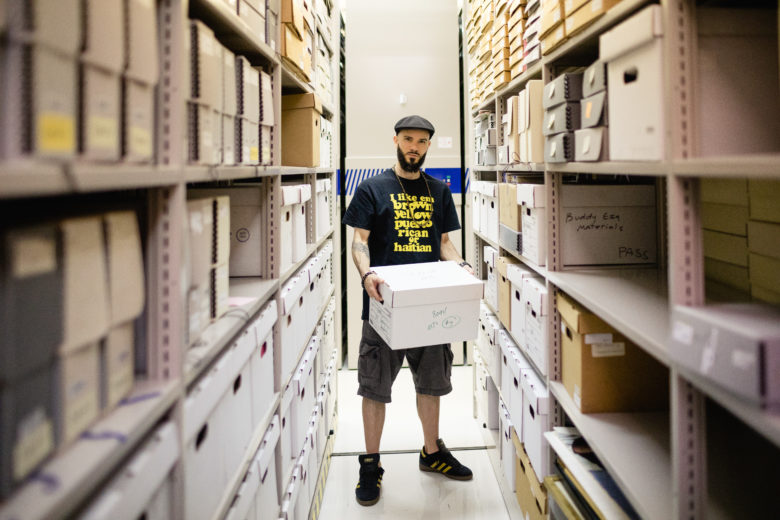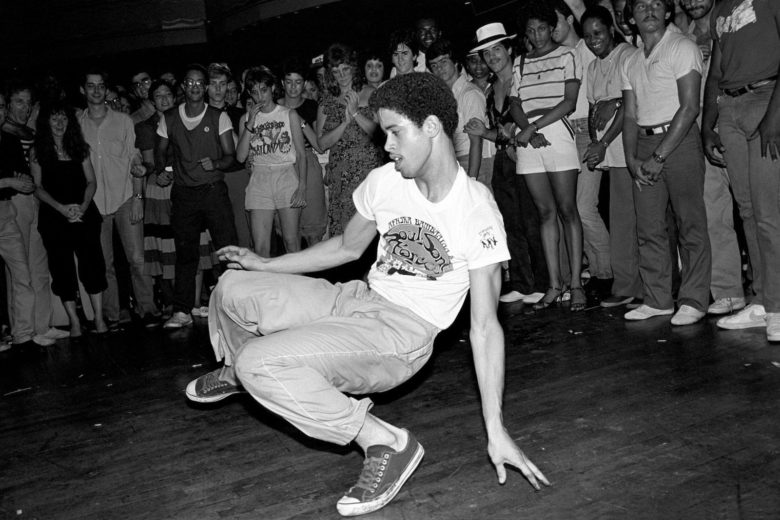
Latinos have always been at the helm of creating hip-hop culture. Now they are helping preserve it as well.
The adage goes, tell your own stories. But in a time of lightning-speed news cycles and trends, equally important question is, who is documenting them? How are they being preserved? This became the question for many hip-hop pioneers who had amassed huge collections of memorabilia from photos to cassette tapes, of the culture. When they wanted to securely store them for future generations, there was nowhere to put them. That was until 2007. Enter the Cornell Hip Hop Collection (CHHC).
The Library of Rare and Manuscript Collections of Cornell University is home to a storage vault three stories underground that spans a football field. The CHHC preserves over half a million artifacts documenting the origins of Hip-Hop culture. It’s made up of dozens of archives that include artwork, photographs, flyers, all forms of music, books and other collectibles from prominent artists, journalists, photographers, record labels and public relations firms. Contributors include prolific photographers Joe Conzo, Jr., Ernie Paniccioli, film director Charlie Ahearn, hip hop Renaissance man Bill Adler and B-Boy Richard “Crazy Legs” Colón.
Ben Ortiz, the collection’s assistant curator, has been vital to building CHHC since its inception, first as an advisory board member and then in 2011 when he took on his current role. We caught up with Ortiz to discuss the significant Latino contributions to the collection, breaking down the ivory tower and the importance of the archives at this moment of racial reckoning.
‘LLERO: How did the Cornell Hip-Hop Collection come to be?
Ben Ortiz: In summer of 2007 the first group of materials arrived at Cornell. A lot of the groundwork for it goes back to 2006. The book, Born in the Bronx, was essentially put together by this guy named Johan Kugelberg. He had met Joe Conzo, Jr. in the early 2000s. They began collaborating on what would become Born in the Bronx which features Joe’s photographs, as well as flyers designed by Buddy Esquire, Esquire, King of the Flyers, and images of vinyl record labels that Johan had collected. He was putting together a collection of vinyl records that to him would represent the earliest known group of rap recorded on wax. As well as a few other things thrown in the mix. So that’s what Born in the Bronx is.
Upon completing that book in 2006, Johan began looking for an institution to sell all this material to so it could be institutionalized. Johann had a collection of roughly 6,000 items-fliers and vinyl records – and he was shopping around for the right home for that material. He eventually met Catherine Reagan, she’s a curator of rare books and manuscripts at Cornell University.
She met Yohan and said she was interested in bringing this collection to our archives [for] a couple of reasons. Not only is the material fascinating, interesting and unique, but it also helps to fill in several gaps that existed in the archival historical records of our university: Documenting the experiences of people of color, people who are on the disadvantaged end of the socio-economic spectrum, and young people, pop culture, etc.
The vast majority of the historical documentation Cornell had before this starts from 1800s and backwards. There are some serious gaps. Johan had an additional component to this initiative. He more or less insisted that two other things take place. Number one, that his archive would not be the “one and only” Hip-Hop Archive. In other words, that the university would agree to add and build upon it. That’s why it’s called the Hip-Hop Collection–it’s a collection of archives. The second was that when funding became available, a full-time curator would be hired. And that became me.
‘LL: What do you do in your role as Assistant Curator?
Ortiz: I’m responsible for communicating the story of hip hop to audiences that most times don’t really have a deep knowledge about hip hop. On occasion, I get to have a roomful of hip-hop heads because they’re visiting from wherever. But most of the time, I’m explaining what hip hop is and how it came to be and that is a big responsibility.
I’ve got my dream job! Even talking to you right now, it’s a real function of my job because [I do] community outreach. I want the whole world to know about what we’re doing, especially people in communities that don’t have a historical entry point to a place like Cornell University. I want those people to feel a sense of belonging here and that they are very much able to and use these research materials for whatever they’re working on. You don’t have to have an affiliation with a major media outlet; you don’t have to be a student.
Somebody from the one of the school districts in D.C. reached out because he’s putting together a text book on music. It’s going to include a chapter about hip-hop and he needed some materials for that. It’s all about people knowing that we exist and that we’re open. People think of the phrase “the ivory tower“ and the exclusivity of it, I’m trying to break that down. That is not that something I’m interested in seeing perpetuated here.
Catherine and I are the two people truly involved in the building of the collections. That requires forming relationships with people who have archives and then determining that we are, in fact, the best home for their archives. And then the whole process of moving their archives to a physical vault from their home. It’s an involved process.
‘LL: Are there workshops and presentations offered about the CHHC? Who and what do you typically teach?
Ortiz: The vast majority of presentations I do are for specific audiences who invite me to speak. That includes professors who incorporate my lectures into their syllabi. Any group anywhere on the planet can certainly reach out and request a presentation. Presentations for the public to see on the internet have been very rare for a number of reasons. But now that we are in this age of daily video connectivity, that will become much more frequent, starting this fall semester. My talks are usually about the history of Hip Hop, and the details about archiving it. I’ve also taught a for-credit semester-long course, as well as week-long summer courses for Cornell alumni.
‘LL: In your opinion what has been the importance Latino contributions to this collection and Hip-Hop in general?
Ortiz: I can sum it up by saying that we were involved in the birth of hip hop essentially from day one. To be more specific Puerto Ricans in New York City is primarily who we’re talking about. That’s not to say there weren’t other people in the mix because there certainly were different ethnicities and subgroups involved. But for the sake of history, it’s important to talk about it. Latinos have been in hip hop forever. It’s almost like if it wasn’t a marketing point for record companies, they wouldn’t recognize it.
Big Pun came along in the mid 90s and then his album was the first hip hop album to go platinum by a Latino in 1998. The [media response was] ‘Wow, isn’t that incredible?’ Before him there were The Fat Boys and Prince Mikey D is Puerto Rican; The Cold Crush Brothers and DJ Charlie Chase. I can go through the entire history of Latinos and hip hop and you’ll see that they are there every step of the way. It took Big Pun going platinum for that somehow to [legitimize it.] We think of Hip-Hop as a “black” art form, which it is, but it is also a Latino art form.
‘LL: Considering the racial reckoning happening in our country, why is this collection important to know about at this moment?
Ortiz: We’ve already seen music and art that can be classified as “hip hop” music and art coming out and being inspired by this moment. We’re probably going to refer to this as the George Floyd, Brianna Taylor, Ahmaud Arbery moment in history, that’s only going to continue going forward. When we’re dealing with what the moment is really all about, there’s going to be an extraordinarily close examination of policing and power structures going forward. And Hip-Hop was the canary in the coal mine for that.
This moment can’t be wasted. But I have a hypothesis that the popularization of hip hop is a major component that led to the awakening or “wokeness” of all the white people out in these protests. That’s not to say there weren’t white people marching in the civil rights movement. There were, but nowhere near the numbers you see now. I just have a hypothesis that the mainstreaming of Hip-Hop is a component here.
‘LL: And do you have a favorite part of the collection or are they all like your babies?
Ortiz: The totality of it [the collection] is the great part about it. But I think right now, one thing that I love to teach, that seems especially prescient, is a pamphlet that was produced by the Universal Zulu Nation and handed out at jams and their get-togethers. It’s called ‘What to Do If You’re Arrested or framed by the police in the United States.’ And it’s from the early 90s and it actually doesn’t have a specific date, an oversight I think. It’s got actual pro bono legal advice and this thing is like 20 pages long. This pamphlet is trying to educate the community so that everyone has an awareness of how the system works. It’s intricate and nowhere in this document is the phrase hip-hop mentioned. And yet this particular artifact is one of the most hip-hop artifacts that we have because it’s using the art forms to communicate this crucial knowledge about something. I think that’s hip hop at its best, when the art forms are a vehicle for knowledge.
‘LL: What’s next for the Hip-Hop Collection?
Ortiz: As far as future exhibitions are concerned, everything is up in the air, you know. But we are about to launch a group of materials online that we got digitized recently from hip hop photographer Ernie Paniccioli. His archive is [about] 150,000 images, maybe more. We embarked on the process of digitizing a massive chunk of it, which is about 21,000 images. So, we’re getting ready to launch this Website and it is going to be a trove of material that people can view as an online exhibition.
We also have Crazy Legs’ archives. He and I are working on a lecture series about it for this fall. It’s going to be all completely on Zoom, but it’s a discussion series about Latinos and hip hop, and it’ll be open to the public. Joe, Conzo, Jr. is also involved. I don’t have the dates yet but we’re working on that.
‘LL: What have you learned since taking on this job?
Ortiz: I’d say the most crucial lesson is the importance of communicating to communities about ensuring that they actively document themselves and preserve as much of that information as possible.
Find more info on the Cornell Hip Hop Collection online and on social media.

